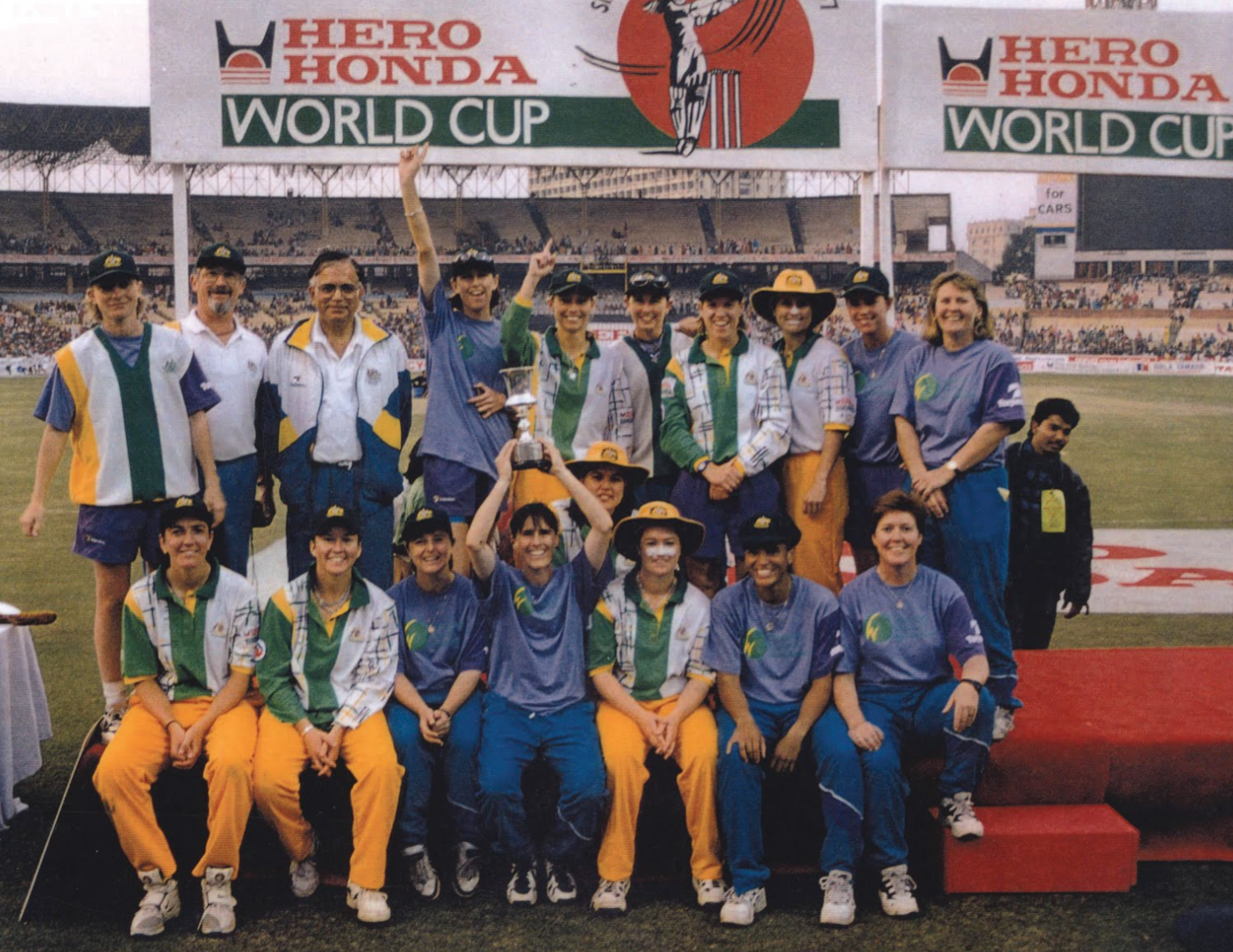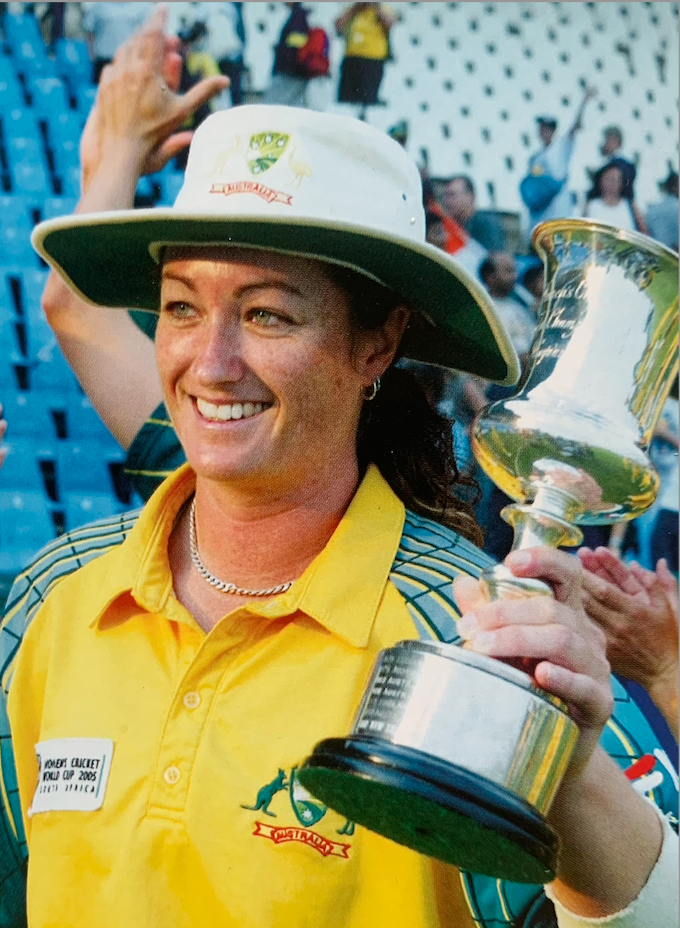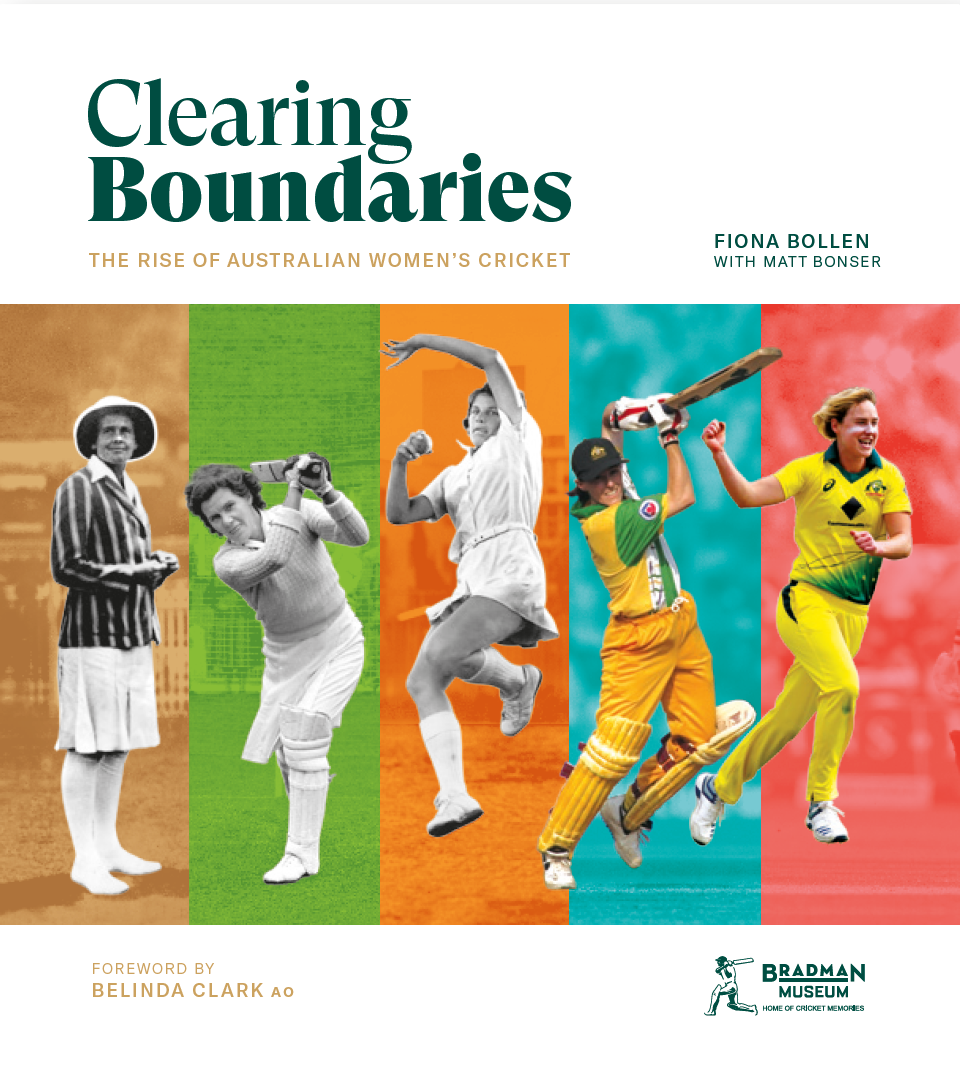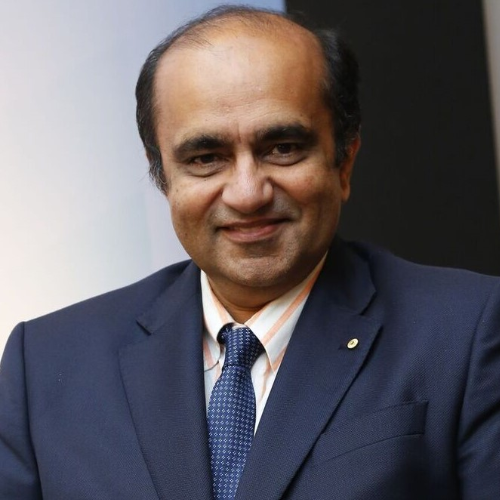Originally published as: On The Shoulders of Giants: Australia’s Quest for Seventh ODI World Cup
***
From Margaret Peden to Meg Lanning, we are blessed with Australian women who have made such a positive impact on the game of cricket.” – Belinda Clark AO
Over the last two years in particular, the Australian team has rightly been thrust into the spotlight. A champion, record-breaking side, names like Lanning, Perry, Mooney and Healy are superstars in their own right. They have now secured Australia’s seventh ODI World Cup, undefeated through a record-breaking campaign in New Zealand.
Part of a strong lineage of women in Australian cricket, Lanning’s team do not thrive in isolation, instead, they stand firmly on the shoulders of giants. Inspired by the passionate, resilient and fearless women who have come before, they are able to thrive on the world stage; inspiring girls and boys across the country.
So, with thanks to quotes, insights and photos from Clearing Boundaries, we are proud to reflect on some of the success and struggle that has helped pave the way for the current Australian team.
1973: On The World Stage
“Thanks to Rachel Heyhoe Flint’s effort, an exciting new era was heralded by the women’s World Cup – which came into existence two years before the men had a similar event.” – Clearing Boundaries
The women’s game was shifting gear in the 1970’s, its proliferation coinciding with the growth of the feminist movement. In 1973, it was set to go to the world stage, when cricket’s first World Cup was held in England.
The final standings and scores from the ‘Final Match’ between England and Australia. (Clearing Boundaries P. 60)
Two years in the making, the tournament was the brain-child of England captain Rachael Heyhoe Flint and benefactor, Sir Jack Hayward, who were keen to see teams from around the world come together and play a World Cup.
Played across England, the seven-team competition was contested in a round-robin format, with the champions to be decided by the points table instead of a scheduled final. The first official One Day Internationals for women, it was a truly ground-breaking month for players, supporters and the sport more broadly.
England and Australia – predicted to be the strongest teams in the tournament – were scheduled to play the final match in place of a dedicated final. Held at the historic Edgbaston Cricket Ground, it was not a particularly close affair, England emerging as victors and consequently as champions of the inaugural World Cup.
Though they were not victorious, the tournament marked a pivotal moment for Australia, too. Fast bowler Tina Macpherson (5/14) claimed the first ‘five-for’ in Women’s ODI’s in the first match, and the enterprising, entertaining cricket had ensured that the World Cup would become a regular feature in the international fixture.
1976: Breaking Old Ground
Following the watershed World Cup, the liberation and expansion of women’s cricket continued, as England’s Women’s Cricket Association campaigned fervently to play a women’s match at Lord’s.
For more than 160 years, women had been excluded from the Marylebone Cricket Club. The Queen the only woman permitted in the pavilion, no women’s match had ever been played on the hallowed turf. That changed in 1976 when England and Australia played the second ODI of the tour at Lord’s.
England women waiting to bat on the balcony. The players were the only women in the pavilion; membership to the MCC was only granted to females in 1999. (Clearing Boundaries)
Sharon Tredrea (54) reached the first milestone in the historic match, but it wouldn’t be enough for Australia, as England chased down a modest target of 161 with eight wickets to spare.
1978: Crowning Glory
Just over four years since the inaugural World Cup, the tournament travelled to India in 1978. Initially in jeopardy, the late withdrawals of the Netherlands and the West Indies threatened the viability of the second iteration, but Australia, England, New Zealand and hosts India were determined to play on.
The final standings and scores from the ‘Final Match’ between England and Australia. (Clearing Boundaries P. 66)
Once again, Australia and England were scheduled to play in the last match of the round-robin in a de facto final. Again, the two highest-ranked teams coming into the match, the result was different this time around, as Australia cruised to victory in Hyderabad. A green wicket that offered enough for the bowlers, Sharon Tredrea (4/25) and Marg Jennings (57 no) were instrumental in that final match and ensured the World Cup came Down Under for the first time
1982: Keepers of the Cup
A marathon format with a designated final included for the first time, the 1982 World Cup saw all teams play each other three times in just under a month. A lengthy stretch, Australia recorded an incredibly impressive eleven victories from their twelve round matches. Lyn Fullston led the charge for the defending champions, as she claimed 23 wickets over the course of the tournament with her left-arm orthodox spin.
Sharon Tredrea (L) and Raelee Thompson (R) with the silverware. (Clearing Boundaries P. 68)
In the first official final, Australia and England would face off yet again. A nerve-jangling affair on a challenging wicket at Christchurch, England set Australia 152 for victory. Despite three run-outs, valuable contributions from Jen Jacobs (37) and Karen Read (32) saw Australia over the line with six balls remaining.
1988: A Hat-Trick at Home
Although it had been six years between World Cups, there was added impetus for the Australian side in 1988; they had the chance to make it three in a row and to complete the feat on home soil.
The 1988 iteration saw the tournament debuts of both the Netherlands and Ireland as matches were played in Melbourne, Sydney, Canberra and Perth.
Once again, Australia were dominant through the group stage, losing just one match to England. Lindsay Reeler was the star for the home side, as she amassed 448 runs from her eight innings, while Lyn Fullston led all comers with the ball with 16 wickets.
Predictably, Australia met England in the final. Played at the Melbourne Cricket Ground, it was the first-time women had played at the historic ground in almost 40 years, and the Australians made it count. A low-scoring affair, the hosts were set a meagre 129 for victory, a task which they achieved with relative ease; losing just two wickets in the chase.
Three World Cup victories in a row, Australia had established themselves as the dominant force in women’s cricket.
The victorious Australian team celebrate at the Melbourne Cricket Ground. (Clearing Boundaries P. 82)
Following two decades of profound growth, spurred on by four World Cups, the women’s game was set to enjoy a period of profound transition. A process aided by increased participation and professionalisation, the women’s game shifted its focus primarily to shorter formats, embracing coloured clothing, increased sponsorship, coverage and interest.
1997: Into the Record Books and Triumph in India
In the 18th match of the 1997 World Cup in India, Belinda Clark wrote herself into cricketing history as she made the first-ever double century in One Day Internationals. Her astonishing innings of 229 no against Denmark included a whopping 22 boundaries and came from just 155 deliveries. An indomitable display, Clark helped Australia to an imposing total of 3/412 as Australia won by an incredible 363 runs.
More than her contributions with the bat, Clark’s leadership throughout the tournament was instrumental to Australia’s success. They finished on top of the group stage and a narrow victory against India in the semi-final meant they would face New Zealand in the final.
Belinda Clark bats at the 97 World Cup (Clearing Boundaries P. 103)
A triumph for women’s sport as much as women’s cricket, Australia and New Zealand played the decider in front of a packed house at Eden Gardens. Though official numbers at the gate were not recorded, estimates suggest up to 80,000 crammed into the stadium. Included in those was a young Jhulan Goswami who was that day inspired to pursue a career in cricket. Today, the Indian seamer stands as the most successful bowler in the history of the World Cup, with 43 tournament wickets to her name.
The match itself was a close one, Australia set 164 for victory, again it was Clark (52) who helped guide the team home, as they secured victory with five wickets and 14 balls to spare.

World Cup Champions in 1997 (Clearing Boundaries P. 104)
2005: High-Five
On their first tour of South Africa, Australia was out for redemption, after New Zealand claimed the cup in 2000. A side flush with talent and experience, Australia were untroubled through the group stage. In the semi-final, experienced heads prevailed as Cathryn Fitzpatrick (3/27) and Belinda Clark (62) helped Australia through to a place in the final.

Karen Rolton, centurion and player of the final. (Clearing Boundaries, P.128)
They would face India in the final at Centurion. A team that was playing in their first World Cup decider, it was always going to be a big ask against the experienced Australians. Batting first, Australia was treated to a Karen Rolton masterclass, as she anchored the innings with an invaluable 107 no. A classy knock, it helped Australia to 4/215, a total they easily defended with the ball as they bowled out India for just 117.
An incredible fifth World Cup, Australia had established themselves as a truly dominant ODI team.
2013: Super Sixth
By 2013, the growth of the women’s game meant that the World Cup prize pool had surged to $200,000. An indication of the rapid progress it had made, it was a landmark moment in the tenth edition of the tournament.
Once again, Australia were dominant throughout the group stage and only lost one match en route the final. A team that featured Lanning, Perry and Haynes – all of whom continue to represent Australia with distinction – Australia faced the West Indies in the final.
Perry and Sthalekar celebrate a wicket in the final. (Clearing Boundaries P. 152)
A comprehensive performance on the biggest stage, Jess Cameron (75) and Ellyse Perry (3/19) were the stars for Australia as they recorded a 114-run victory. Australia’s last triumph at an ODI World Cup, it also proved to be a fitting end to Lisa Sthalekar’s glittering 12-year career.
***
Nine years on and Australia have repeated the dose. Inspired by generations of players, administrators and volunteers before them, the current crop of players have earned a record seventh World Cup title; writing their own chapter in Australia’s proud cricketing history.
***
Read more or purchase Clearing Boundaries HERE

Join the cricket network to promote your business and expertise. Make it easy for people to search and find the people and services they need through people they know and trust.
Join the network







